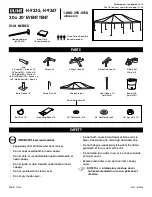
6
7
When packing for your trip, consider the conditions you’ll likely encounter
and what sort of anchors you’ll require. You can often leave several of
the supplied pegs at home and replace them with improvised anchors,
thereby saving weight and space in your pack.
Ventilating the Tent
Proper ventilation is the key to minimizing condensation in any tent. Keep
fabric doors open as widely as the prevailing weather permits. If bugs
or drafts aren’t a problem, leave mesh doors open too. Crack each door
open from the top down; warm, moist air rises and will escape through
high openings. If the design of your tent allows for it, have openings at
both ends or both sides of the tent to allow air to fl ow through for best
ventilation. On very hot nights, when you are confi dent there will be no
rain or dewfall, you can leave the fl ysheet off and use the inner tent alone
as a “bug tent.”
The Opeongo 2 features a roof peak vent which allows rising, warm, moist
air to escape, while encouraging cooler, drier air to fl ow in through other
door and window openings. To open the vent, fasten the two hinged
battens together at the centre using their hook-and-loop surfaces: this
will form a prop rod that holds the vent open. You can adjust the length
of this prop rod, and thereby the vent opening size, by fastening the two
battens together at different places along their lengths. To close the vent,
pull the battens apart, fold them fl at, and seal them down with the hook-
and-loop strip.
Disassembling the Tent
The most important consideration in taking down a tent is not to stress
the poles and fabrics. First, disconnect guylines and release the tension
from the tent. Next, release all the poles. If your tent has pole sleeves,
push the poles out of the sleeves instead of pulling them out. To minimize
the stress on the bungee cord in the poles and to speed disassembly,
fold each pole in half fi rst, and then fold down towards the outsides, two
sections at a time.
Packing the Tent
If possible, fold and roll the tent rather than stuffi ng it into its sack—rolling
makes a smaller package, and causes fewer creases in the polyurethane
coating. The tent and poles may be carried separately for easier packing
or load sharing. There are two drawcords on the tent sack. Use the lower
one when carrying the tent separately from the poles; this makes a
shorter package that fi ts sideways into a pack. If carrying the pole sack
on the outside of a pack, securely attach the drawcord to the pack to
avoid loss.
CARE AND MAINTENANCE
Protecting the Tent
Ultraviolet damage is the single largest hazard your tent faces in its
lifetime. Fabrics should not be exposed to sunlight for extended periods
of time; this will eventually result in colour fading and fabric failure. The
uncoated fabrics of the tent canopy are most susceptible to damage from
UV and should be covered by the more durable fl y. If extended exposure
is unavoidable, cover the tent with a tarp or a sheet of nylon.
Lighting the Tent
Using a candle lantern in a tent carries defi nite risks. Never leave a candle
lantern burning unattended; always watch for fi re hazard from overheating
fabrics or spilling wax. Spilling wax can be dangerous, particularly to eyes
and other sensitive areas. It is your responsibility to use candle lanterns
wisely and with extreme caution: we do not endorse the use of any
fl ame or heat source in a tent. Cooking in a tent is strongly discouraged
because of fi re hazards and carbon monoxide inhalation risks. Unlike
campfi re smoke and other fumes, which cause you to gasp for air,
carbon
monoxide can render you unconscious without any warning.
Food in Tents
Mop up spills promptly with water. Many foods, particularly acidic ones
like fruit or juices, can weaken synthetic fabrics over time. In any case it is
best to eat and store food away from a tent to avoid attracting animals.
Cleaning
Clean the tent by hand while it is set up, using a sponge, a mild non-
detergent soap, and warm water. Rinse thoroughly. Do not dry clean,
machine wash, or machine dry. Stubborn stains like tar can be left in
place and dusted with talcum powder to prevent transfer to other areas
of the tent in storage. After cleaning, a spray-on water repellent designed
for synthetic fabrics may be applied to the fl ysheet if surface water
repellency is weakening. (This is apparent when water droplets no longer
bead up on the fabric.)
If the poles are exposed to salt or salt water, rinse them in fresh water and
allow them to dry before storing. (While aluminum does not rust, it can
become brittle through unseen corrosion over time.)
Lubricating the poles
Occasionally apply a light coating of a silicone-based lubricant like 303™
protectant to the tent pole connections. If the poles are used extensively























